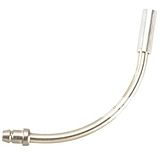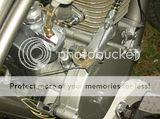This is going to be a bit of a tough problem to explain. I have a brand new engine now, and I am trying to get the clutch adjusted right. So far, each time I get the clutch adjusted, about 5 mins of riding I find the clutch stops working and the whole clutch cable/arm is loose and floppy. I would then proceed to slide the little clutch wire clip up (about a full cm each time) until it works again. This cycle has repeated itself enough times now that the clutch doesnt even begin to engage until the clutch arm is practically touching the clutch screw base (the thing that screws into the crankcase) If you were to think of the clock analogy where 12 oclock points to the right side gear cover, the clutch arm is completely loose (does not even begin to move the rod) until about 2 oclock. The last engine I had would engage the cluch at about 5 oclock. The first time I ran the engine it was at 5 oclock, and has slipped up to 2 oclock over the course of less than an hour. I've been poking around and messing with the clutch flower nut, but I am convinced that the problem isnt on the right side of the engine since it doesnt even move anythign on the right side until 2 oclock.
What on earth can be happening here? Its a brand new engine.
Matt
What on earth can be happening here? Its a brand new engine.
Matt








